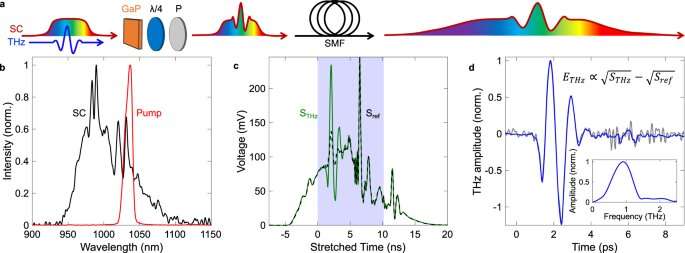This article has been reviewed according to Science X's editorial process and policies. Editors have highlighted the following attributes while ensuring the content's credibility:
fact-checked
peer-reviewed publication
trusted source
proofread
Unveiling the invisible: A breakthrough in spectroscopy to allow discoveries in materials physics

Scientists from the University of Ottawa and the Max Planck Institute for the Science of Light are proposing a breakthrough approach that will facilitate discoveries in materials science by combining terahertz (THz) spectroscopy and real-time monitoring.
Terahertz waves are electromagnetic waves that can reveal hidden secrets of matter. They can capture fast changes in materials invisible to other types of radiation. Scientists can now use terahertz waves to record real-time movies of hot electrons in silicon at 50,000 frames per second—faster than ever before.
Led by Jean-Michel Ménard, associate professor of physics at the University of Ottawa's Faculty of Science, a team of scientists used two techniques, chirped-pulse encoding and photonic time-stretch.
The study, "Single-pulse terahertz spectroscopy monitoring sub-millisecond time dynamics at a rate of 50 kHz," was published in Nature Communications.
The first technique imprints the information carried by a THz pulse onto a chirped supercontinuum in the optical region, which resembles a traveling rainbow. The second stretches the rainbow pulse in time inside a long fiber, slowing down the rate of information so that it can be recorded in real time by advanced electronic equipment. These steps are repeated using a train of pulses at 20 microsecond-intervals, which can be combined to make a movie of the low-energy dynamics inside a material.
"In this study, we present a novel photonics system that can measure in real time the low-energy dynamics of complex physical phenomena with a time resolution approaching the microsecond. Our setup is distinctive: It is a compact system that replaces a technology that was only accessible in large synchrotron facilities, and can quickly perform time-resolved THz spectroscopy, a powerful technique to analyze various materials," says Ménard.
What's next?
Experiments relying on this system will trace vibrational resonances of molecules to study the enigmatic role of enzymes in chemical reactions and observe invisible changes in living organisms when they're exposed to a sudden rise in temperature.
"In condensed matter experiments, our rapid THz photonic system will be used to observe a range of non-reversible electronic or lattice reconfigurations, notably occurring during phase transitions," says Ménard. "We anticipate that (this) will play a crucial role in revealing a new range of fast and non-reproducible processes rendering THz spectroscopy an even more efficient characterization tool to make impactful discoveries in materials physics."
The researchers' photonic system allows them for the first time to investigate behaviors of irreversible physical, chemical and biological phenomena, including electronic transport in semiconductors, chemical exothermic reactions and protein folding in biological systems. It's unveiling the hidden dance of quick and unpredictable dynamics, forever altering our understanding of the world.
More information: Nicolas Couture et al, Single-pulse terahertz spectroscopy monitoring sub-millisecond time dynamics at a rate of 50 kHz, Nature Communications (2023). DOI: 10.1038/s41467-023-38354-3
Journal information: Nature Communications
Provided by University of Ottawa



















